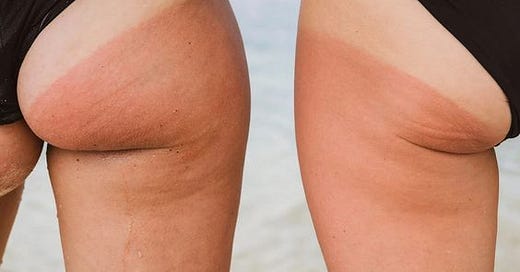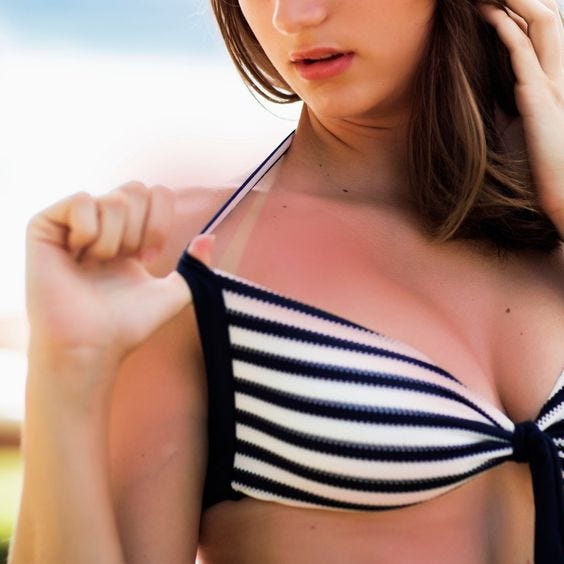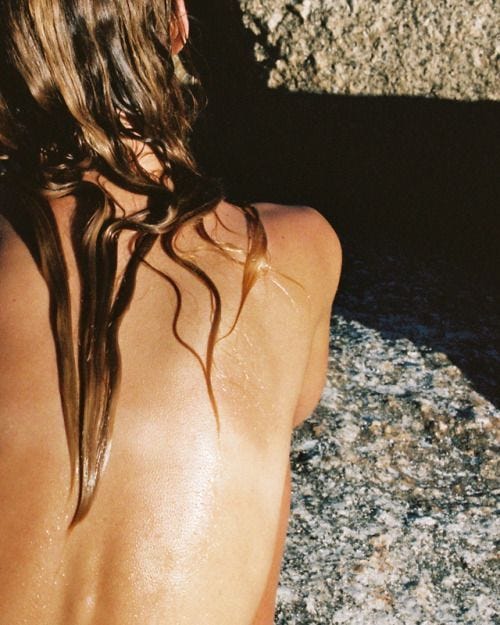If you tan without sunscreen, many well-meaning people will tell you to “enjoy your skin cancer.”
Sadly and ironically, such misinformed souls are actually the ones headed for a life of pink skin and skin cancer.
In this article I will show you exactly why the sun poses no inherent threat to your skin health, and that the real cause of skin cancer, skin damage, and even sunburn, is seed oils.
History or Skin Cancer
80 years ago, before heliophobia (fear of the sun) conquered American society, you would’ve just gone outside and frolicked in the sun, sunscreen free, with not a care in the world.
And guess what— skin cancer wasn’t a relevant threat.

Not only was it virtually undiscussed in any literature, the available data show an alarming increase (2000% in this study!) in skin cancer rates since 1950.
But perhaps people are just living longer, and therefore more likely to develop skin cancer?
That wouldn’t explain why childhood skin cancer has increased about 2.5% per year since 1970.
What if they’ve been spending more time in the sun?
Unlikely, given the prevalence of desk jobs, commuting, TV, and video games.
And they didn’t wear substantively more clothing when in the sun then either.
Besides, humans have been evolving outside under the golden touch of the sun for millions of years. If skin were so susceptible to sunlight, we would have never made it out of the trees.
The mechanism of skin damage
But don’t we already know that UV radiation causes sunburn and skin cancer? After all, sunscreen wouldn’t be a $14B industry for nothing, right? Case closed.
It’s true, skin damage is indeed induced by UV radiation.
More specifically, lipid peroxidation aka oxidative damage is one of the major (if not the main) mechanisms by which UV damage “promotes photocarcinogenesis and photoageing” (aka, skin cancer).
In fact, the degree of skin damage can be measured by the amount of lipid peroxidation present in the skin.
The physiology is abundantly clear: UV light causes lipid peroxidation, which is the cause of damage to skin cells and DNA, which ultimately leads to cancer.
Therefore since UV light is the trigger of skin damage, if you reduce the UV light, then you shouldn’t get skin cancer. At least that’s the premise behind every sunscreen sales pitch.
But does it work?
Benefits of UV
Much to the chagrin of sunscreen manufacturers, reducing sun exposure doesn’t seem to be helpful for lowering cancer rates or general health.
Aside from the fact that the sun is the source of all life on earth and has been around since well before the 1950s, UV light is actually beneficial. And not only for vitamin D production.
And in Europe (i.e. among fair-skinned people), skin cancer was actually found to increase with less sun exposure.
But how could reducing sun exposure not help? After all, it’s hot, and “burns” come from hot things. Seems to make sense.
Seed Oil Decay
Recall from above that skin damage has two steps: UV light, and lipid peroxidation.
If you’ve read my other articles, you’ll know that lipid peroxidation is a pedantic term for seed oil decay: i.e., the decomposition of unstable poly-unsaturated fats (PUFAs) from seed (and fish) oils into reactive substances like aldehydes and lipofuscin.
If increasing UV exposure is not to blame for the population-wide increase in skin damage, then maybe increasing lipid peroxidation is.
And where does lipid peroxidation in the skin come from? Eating PUFAs of course.
And when did PUFA consumption really take off in the US? In the 1970s.
When you realize that sensitivity to UV light increases with PUFA consumption, as does the incidence of skin cancer, then it all starts to make sense: lipid peroxidation is the real cause of skin cancer that’s become more prevalent since the ‘70s.
As such, reducing it should actually reduce our skin damage. And it does.
The UV is like a match, and seed oil-filled skin like firewood. Without both, you can’t have a campfire.
Without both UV and lipid peroxidation, you don’t have skin damage.
And since UV exposure is natural, but seed oil filled skin is not, reducing seed oils in your skin is the correct way to protect yourself.
Conclusion
You’ve been lied to. The sun did nothing wrong. It was the seed oils this whole time.
And now that you understand the true cause, you need not fear the sun any longer. Time to overcome the heliophobia and partake in the many boons that sun exposure can bestow on your health and wellbeing.
But before you book a one way ticket to Tulum for some tropical radiation, first check out my guide to safe sun exposure.
If you heed my advice on tanning and sunscreen, not only will you develop a glorious tan as you lay unhindered in the midday sun, you will also be protected from skin cancer as you age, while seed-oil-swilling sunscreen users will not.
Bonus Round: Rebuttal Rebutted
While I think this line of reasoning is quite compelling, certain pale individuals will still “rebut” this conclusion with one all-too-predictable counterargument.
I think it’s very instructive to break it down, so I will address it below. But I wouldn’t want to make redditors feel bad in public, so it’s behind a paywall.
If you are interested in methods of defending your correct opinions against internet midwits, definitely check it out.
Keep reading with a 7-day free trial
Subscribe to Tan Land: Natural Health and Beauty to keep reading this post and get 7 days of free access to the full post archives.










